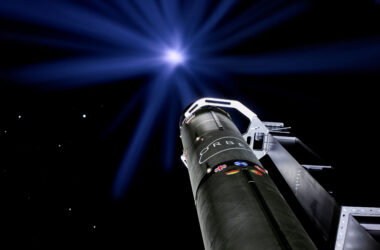The UK Ministry of Defence (MOD) has awarded Airbus a £127 million contract to design and build the Oberon satellite system. The deal aims to significantly enhance the UK’s capabilities of space-based intelligence, surveillance, and reconnaissance (ISR).
Oberon will consist of two synthetic aperture radar (SAR) satellites equipped with advanced imaging sensors. SAR technology enables high-resolution imagery to be captured day and night, regardless of weather conditions. This is a key advantage over traditional optical imaging satellites, which can be limited by cloud cover or lack of illumination.
The Oberon satellites will build upon the technology and lessons learned from Tyche, the UK Space Command’s first satellite, which launched in August 2024.
Images released from Tyche have already demonstrated its ability to capture detailed imagery worldwide, revealing activity at military sites and assisting with disaster response.
The Evolution of Synthetic Aperture Radar (SAR) Technology
Synthetic Aperture Radar (SAR) is a powerful remote sensing technique that has improved earth observation and intelligence gathering in the last 50 years. Unlike traditional optical imaging, SAR systems actively illuminate the target area with microwave pulses and record the reflected signals. This allows SAR to collect high-resolution imagery regardless of weather conditions or time of day.

Above – This radar image acquired by the SIR-C/X-SAR radar on board the Space Shuttle Endeavour shows the Teide volcano. The city of Santa Cruz de Tenerife is visible as the purple and white area on the lower right edge of the island. Lava flows at the summit crater appear in shades of green and brown, while vegetation zones appear as areas of purple, green and yellow on the volcano’s flanks.
The origins of SAR technology can be traced back to the 1950s when Carl Wiley of Goodyear Aircraft Corporation first proposed using Doppler frequency shifts to improve radar image resolution.
In the following decades, aerospace and defence companies like Lockheed, Raytheon, and JPL developed airborne SAR systems for military reconnaissance and mapping.
A breakthrough came in 1978 with the launch of NASA’s Seasat satellite, the first civilian spaceborne SAR system. Despite its short lifespan of only 105 days, Seasat demonstrated the immense potential of space-based SAR for oceanography, geology and ice monitoring.
Several more advanced SAR satellites were launched in the 1980s and 90s, including ESA’s ERS-1/2, Canada’s Radarsat-1, and Japan’s JERS-1. These systems operated in the C-band frequency range (~5.4 GHz) and could achieve spatial resolutions down to 10-30 meters. They found applications in fields as diverse as agriculture, forestry, disaster management, and maritime surveillance.
From 2000 onwards, a new generation of SAR satellites emerged with improved capabilities such as multi-polarization, interferometry and higher operating frequencies (X-band and Ka-band). Examples include Germany’s TerraSAR-X, Italy’s COSMO-SkyMed constellation, and the Airbus-built NovaSAR-1 satellite for the UK. These systems pushed the boundaries of SAR performance, enabling sub-meter resolution imaging and more advanced analytics.
The Oberon satellites, set to launch in 2027, will likely incorporate the latest advancements in SAR technology. This could include:
- High-resolution imaging (potentially down to 25cm) using X-band or Ka-band frequencies
- Full polarimetric capabilities to capture rich information about target properties and geometry
- Onboard processing and AI to autonomously detect and classify objects of interest
- Advanced antennas and electronics to enable larger swath widths and faster imaging speeds
- Laser communications to rapidly downlink vast volumes of imagery data to ground stations
As one of the most sophisticated spaceborne SAR systems ever developed, Oberon has packed in 70 years of innovation in radar remote sensing. It will provide the UK with unprecedented intelligence-gathering capability and situational awareness, cementing SAR’s position as an indispensable tool for 21st-century defence and security.
The Oberon project falls under the MOD’s ISTARI program, which aims to establish a constellation of ISR satellites and supporting ground systems by 2031. ISTARI will provide the UK with world-leading space-based intelligence-gathering capability.
Data and imagery from the ISTARI satellites will support a wide range of military and government tasks, including:
– Monitoring adversary activities
– Providing intelligence to UK and allied forces for operations
– Assisting with disaster response and humanitarian relief
– Mapping and monitoring the impacts of climate change
Air Commodore Paul Tedman, Head of the MOD’s Space Directorate, emphasized the significance of the Oberon contract, stating: “The award of the Oberon contract builds on the success of our Tyche satellite and takes another step towards establishing a sovereign UK space-based ISR capability. It will provide our armed forces and decision-makers with timely, actionable intelligence wherever it is needed.”
The Oberon contract will enhance defence capabilities and boost the UK’s space industry. The project will support around 200 highly skilled engineering and manufacturing jobs, primarily at Airbus in Stevenage and Portsmouth.
The contract was awarded through a competitive procurement process and will leverage expertise across the UK space sector. Notably, Oxford Space Systems will supply novel carbon fibre antennas that stow compactly for launch before unfurling to full size in orbit.
Richard Franklin, Managing Director of Airbus Defence and Space UK, highlighted the company’s decades of experience in military satellite technology, remarking: “Oberon builds on Airbus’ 40 years of experience in delivering ISR satellite systems and will ensure the UK retains a world-leading capability in this field. We look forward to working closely with the MOD and our UK supply chain partners to deliver this landmark project.”
The Oberon satellites are expected to launch in 2027 and operate in low Earth orbit, likely at an altitude of around 500km. Their SAR sensors will rapidly scan vast swathes of the Earth’s surface from this position, identifying potential threats or targets of interest for further investigation.
SAR imagery will be beamed to ground stations in near-real time, feeding into the MOD’s intelligence analysis systems. Fused with data from other ISR assets, this will provide UK defence and security agencies with a rich, multi-layered understanding of the situation.
The contract award for Oberon comes during significant investment and growth in the UK’s military space capabilities. Establishing the UK Space Command in 2021 made space the heart of the country’s defence strategy and planning.
Projects like Tyche and now Oberon show the UK’s ambition to become a significant space power, developing its capabilities while working closely with allies like the United States.
A space-based ISR capability will be vital for the UK to maintain strategic awareness and decision-making advantage in an increasingly complex and contested international environment.
With Oberon set to enter service later this decade, we are well on our way to achieving a step-change in its ability to monitor, understand and respond to threats from space.
TLDR:
- UK MOD awards £127M contract to Airbus for Oberon spy satellite system
- Two SAR satellites to provide high-res imagery day/night, all-weather
- Part of ISTARI program for UK-owned space-based intelligence by 2031
- Will support military ops, disaster response, climate monitoring
- Boosts UK space industry supports 200 skilled jobs
- Launches 2027, significant step in UK defence space capabilities








